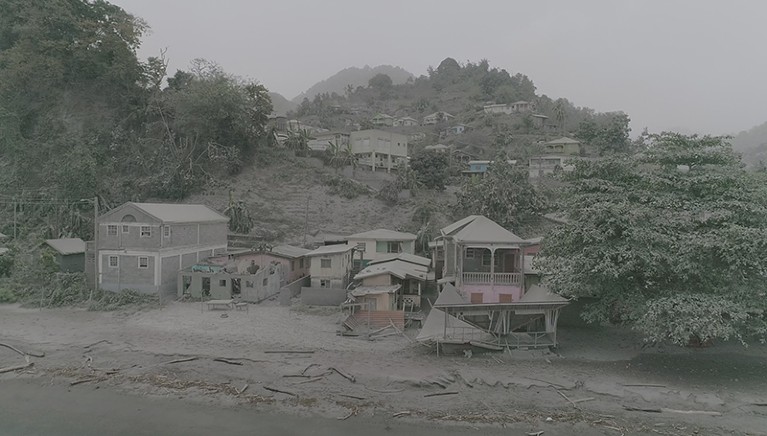
In 2021, the La Soufrière Volcano in St. Vincent and the Grenadines erupted explosively.Credit: Steve Wallace/World Bank
Natural hazards, such as earthquakes, hurricanes, floods, landslides, wildfires and droughts are increasing in frequency and intensity, in large part because of climate change (M. Coronese et al. Proc. Natl Acad. Sci. USA 116, 21450–21455; 2019). In 2022, at least one event occurred every day, according to data from EM-DAT, an international disaster database. And a 2021 report from the United Nations Food and Agriculture Organization stated that the “annual occurrence of disasters is now more than three times that of the 1970s and 1980s” (see go.nature.com/43pmeke).
But natural-hazard events don’t necessarily have to escalate into widespread disasters. Even though they are more common today than they were in the past, the number of deaths from them has drastically declined. In 1920–29, for example, more than 8.5 million people died globally as a result of natural disasters, compared with just over 503,000 in 2010–19, according to data from EM-DAT. This can be attributed partly to improvements in disaster risk reduction and preparedness measures. Nature talked to five disaster researchers about how they are working to reduce the risks and impacts of natural-hazard events.
EROUSCILLA JOSEPH: Volcanic activity under lockdown
Volcanologist at the Seismic Research Centre at the University of the West Indies in Saint Augustine, Trinidad and Tobago.
Here in the West Indies, we face hurricanes and tropical storms every year, and flooding, landslides and volcanic eruptions are routine. I work for the Seismic Research Centre at the University of the West Indies in Saint Augustine, Trinidad and Tobago, which began monitoring seismic and volcanic activity in the region 70 years ago. We cover an area of 800 kilometres, stretching from the islands of Saint Kitts and Nevis down to Trinidad and Tobago. We monitor 9 territories and 17 volcanoes.
In 2008, I became the first student to officially graduate with a PhD in volcanology from the centre. In March 2020, COVID-19 hit. That December, the La Soufrière volcano on Saint Vincent and the Grenadines erupted, beginning with a slow extrusion, but becoming explosive on 9 April 2021. It was truly a trial by fire to navigate that process during a pandemic, under lockdown and without vaccines.
Nature Spotlight: Disaster preparedness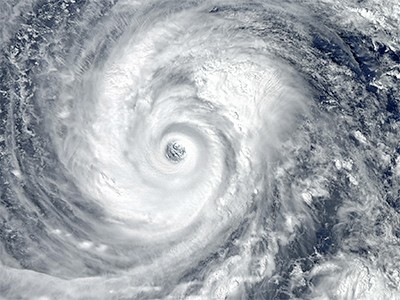
Seismic data and information from satellite imagery warned us of unusual activity two days after Christmas. Some staff members at the Soufrière Monitoring Unit of the Saint Vincent and the Grenadines’ National Emergency Management Organisation went up to have a look, and they saw that a new dome had emerged from the floor of the crater. We immediately deployed staff to reactivate the local observatory, upgrade the monitoring network, provide real-time updates to the authorities and support education and outreach related to the volcanic activity (E. P. Joseph et al. Nature Commun. 13, 4129; 2022).
The eruption started off effusively, and we had to put measures in place to deal with the possibility of it transitioning to explosive. Effusive means that magma erupts at the surface of a volcano and forms a lava flow or dome, whereas explosive describes when magma explodes out of a volcano, often sending ash, gas and lava into the air. On the basis of the data we saw, we provided advice to the prime minister of Saint Vincent and the Grenadines, the government of Barbados and several other disaster-management agencies on the likelihood of an eruption, so that they could raise alert levels and start coordinating a response.
We helped with communication to stakeholders and the public about what was happening and how to prepare. Because of limited resources and the pandemic, the centre’s outreach team had to hold virtual community meetings and use trucks with megaphones to keep people informed. In April 2021, the activity of the volcano began to change. More than 22,000 people were evacuated over a period of 24 hours, just before the explosive eruption began. We rotated teams of scientists on the island until November 2021.
We’re a small agency operating in an under-resourced part of the world, and we were able to respond to this volcanic eruption quickly and before any lives were lost. It was a major success, and our achievement was recognized globally by the 2022 Volcanic Surveillance and Crisis Management Award presented by the International Association of Volcanology and Chemistry of the Earth’s Interior. Things can fall apart easily if there is no coordination between the teams, government and disaster organizations. But if you work together and rely on each other, you can push forward, even in an emergency situation.
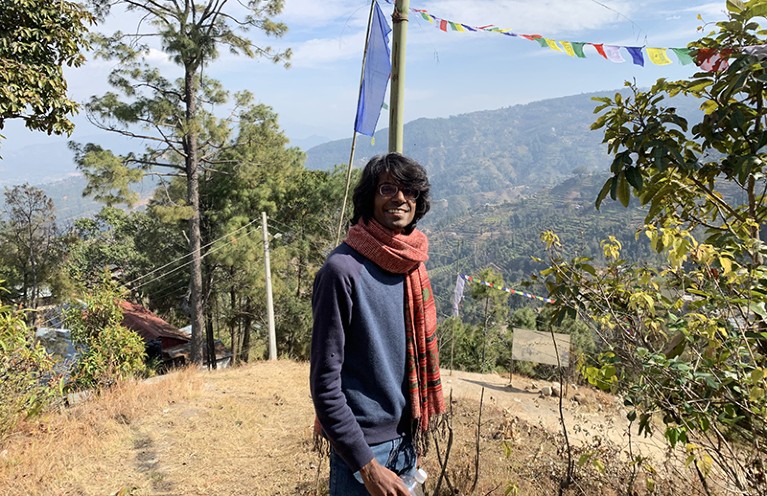
Emmanuel Raju’s involvement in the 2004 Indian Ocean tsunami was a career-defining moment.Credit: Courtesy Emmanuel Raju
EMMANUEL RAJU: Stop blaming nature
Global-health researcher at the University of Copenhagen and director of the Copenhagen Center for Disaster Research.
When you grow up in India, you grow up with natural hazards. I’ve seen a number of cyclones and experienced many school closures due to heavy rains in the monsoon season. At the time of the Indian Ocean tsunami in 2004, I was an undergraduate student studying economics, political science and sociology at St. Joseph’s College in Bengaluru. I volunteered to help mobilize support to some of the main areas that were affected. That experience left a big impression on me. When I graduated in 2007, I learnt that the Tata Institute of Social Sciences in Mumbai had launched a disaster management programme, one of the first of its kind in the region.
Most of my work now deals with trying to challenge conventional notions of how we understand disasters. Disasters are often seen as ‘natural’ in some way, but they occur because of vulnerabilities in society. I work a lot in South Asia. When a disaster occurs, some individuals are disproportionately affected, depending on their social status, caste, religion, gender and other social and economic characteristics. We need to stop blaming nature for the damage caused to the lives and livelihoods of individuals: it is human action and inaction that contribute to many forms of disaster risk.
Another major challenge is breaking disciplinary silos of how disasters are studied. Much of my work at the Copenhagen Center for Disaster Research focuses on bringing together people from various disciplines. You cannot solve issues caused by disasters and climate change with just one discipline. You need different voices from around the world and from many disciplines, including law, economics, physics, social science and health services.
RASHMIN GUNASEKERA: Restoring order after chaos
Disaster risk-management specialist at the World Bank in Washington DC and leader of the Global Program for Disaster Risk Analytics at the Global Facility for Disaster Reduction and Recovery in Washington DC.
Soon after disasters happen, governments are often left in chaotic situations. Officials need to assess the impacts, so they can make decisions about where to send resources and how to quickly get money to the places that need it. The Global Facility for Disaster Reduction and Recovery is a partnership set up by the World Bank and funded by 11 countries that helps low- and middle-income countries to manage and reduce risks from natural hazards and climate change.
Lessons learnt from doing research amid a humanitarian crisis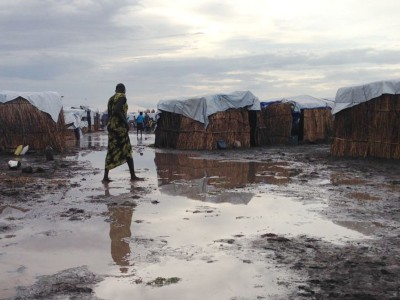
Some of the work I do as part of the programme is to help with rapid assessments of the impact of disasters to give a monetary value to the damages. People go to the field to conduct these assessments, which take about six to eight weeks. Soon after the massive earthquake in Nepal in April 2015, we started using hazard modelling, engineering and census data to estimate the damage remotely. Our assessment methodology has an accuracy of 90% and takes only about two weeks to do.
My work with the World Bank, where I started in 2012, involves assessing risk, which is pivotal for disaster risk reduction and preparedness. It’s a complicated subject area that blends principles of science, technology, engineering and economics. Assessing risk consists of three parts. One is the built-up environment, which captures the types of building in a location, how they are spatially distributed and who lives in them. Another is the type, magnitude and frequency of the hazard itself. The third is vulnerability. I combine these three pieces of information to estimate the future potential for damage.
I strive to build effective partnerships and share knowledge across academia and the private and public sectors. We make our methodology for risk assessment available to anyone who wants to use it. In April, I travelled to Fiji to help some of my colleagues to work out what data sets are available and how to put different types of data together to understand how to represent a built-up environment, and more broadly, how to assess the risk of disaster in this location.
Ultimately, progress can happen only when knowledge is taken up by governments, risk-and disaster-management agencies and academia. I’m still an academic at heart, so one of the most satisfying things to see is the impact of the knowledge you generate.

Emily Chan investigates how extreme events affect human populations.Credit: CCOUC (2016)
EMILY CHAN: Linking human health to the climate
Medical researcher at the Chinese University of Hong Kong (CUHK) and director of the Collaborating Centre for Oxford University and CUHK for Disaster and Medical Humanitarian Response.
As a researcher and practitioner of humanitarian medicine, I try to understand how extreme events might affect human populations. I’ve always been curious about what people do when they experience a disaster such as an earthquake, and why. How do response decision makers and medical workers mobilize resources to help those affected? What do affected people remember, and what do they feel emotional about? Why do researchers choose to document certain information? How do we prevent important knowledge from being carelessly left unrecorded?
A large part of my work involves building models to examine the impact that the climate might have on human health in urban contexts, mostly in Chinese cities. Specifically, I study the impacts of temperature, rainfall, sea-level rise and extreme events on injury, disease, hospitalizations and mortality. For instance, people can have problems with extremely high or low temperatures when they are exposed to them for a prolonged period of time. Rainfall can make freshwater flooding and extreme drought worse, and a rise in sea level can be corrosive and affect the prevalence of infectious diseases such as cholera.
Keep talking to make fieldwork a true team effort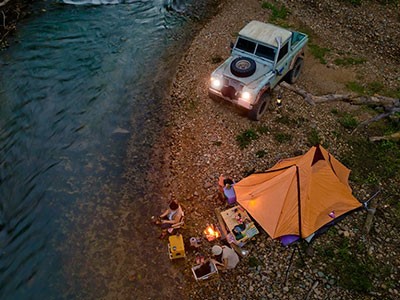
After my colleagues and I began publishing models linking human health to the climate about 10 years ago, we were invited to join a number of committees and talk about our work. Some of our evidence was quoted by the Hong Kong government, and warning policies were changed on the basis of the relationships we found between temperature and mortality (E. Y. Y. Chan et al. J. Epidemiol. Commun. Health 66, 322–327; 2012).
Developing policies is another crucial part of what I do. I’m one of the co-chairs of the World Health Organization’s Health Emergency and Disaster Risk Management research group. In 2020, I became a co-chair of the organization’s COVID-19 Social Science working group. When there are major infectious-disease crises globally, researchers and policymakers need to work together to look at the latest evidence and share it with governments so that they can work out what to do in regards to evacuation, lockdowns, isolation, the use of face masks and even ethical research policies.
STERN KITA: An agrarian economy under threat
Disaster and climate-change researcher at the United Nations Human Settlements Programme (UN-Habitat) in Lilongwe.
In Malawi, the three most common hazards are flooding, drought and strong winds. Because our economy is agrarian, droughts and pest infestations can cause serious cases of food insecurity. We are also affected by tropical cyclones, landslides, earthquakes, fires and outbreaks of cholera and other diseases. I’m often busy.
I worked for the Malawi government for about 11 years and then joined the United Nations in 2020. My work focuses on mitigation and disaster preparedness measures. For instance, I help to develop early-warning systems so that communities are notified of a hazard in advance. I also support projects that protect riverbanks by planting trees to slow the speed of water during a flood, and we’re working to improve drainage systems in urban areas.
In March and April, I travelled a lot to check in on these projects and to support the government in conducting a needs assessment after tropical cyclone Freddy hit the southern part of Malawi. Raising public awareness and building capacity are key parts of my job. I teach disaster risk management at the Malawi University of Science and Technology in Thyolo, and I am helping to build a team that can coordinate and implement disaster risk reduction actions at various levels in the country.
For me, this work is exciting. You can see the results of your efforts and people becoming more resilient to disasters. We have crises almost every day in almost every country. We need to ensure that we provide as much information as we can to build resilience.

 Nature Spotlight: Disaster preparedness
Nature Spotlight: Disaster preparedness
 Lessons learnt from doing research amid a humanitarian crisis
Lessons learnt from doing research amid a humanitarian crisis
 Keep talking to make fieldwork a true team effort
Keep talking to make fieldwork a true team effort
 Pandemic upheaval offers a huge natural experiment
Pandemic upheaval offers a huge natural experiment







